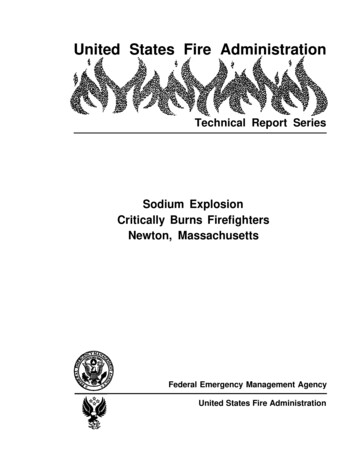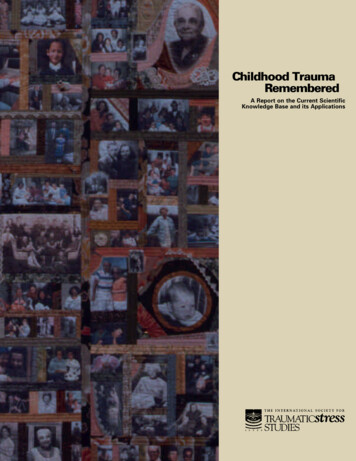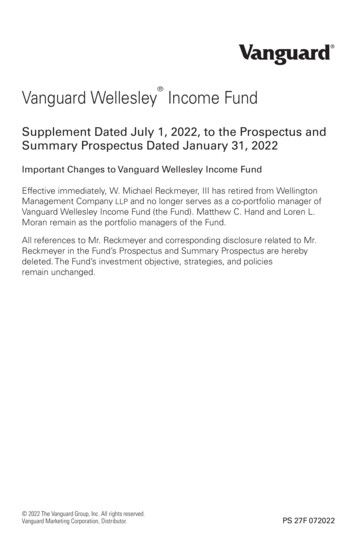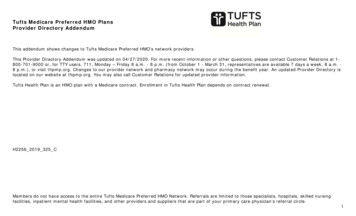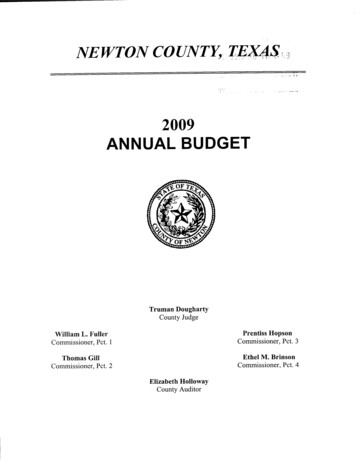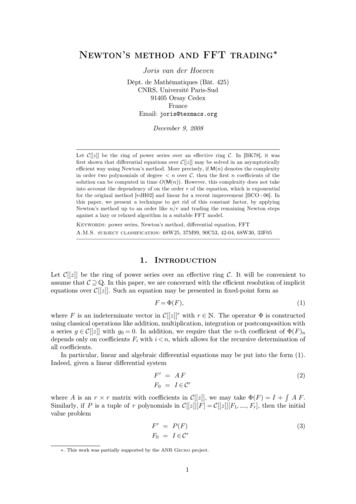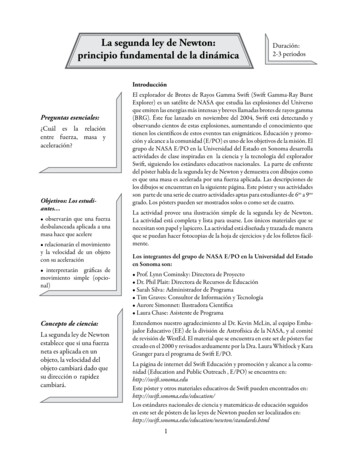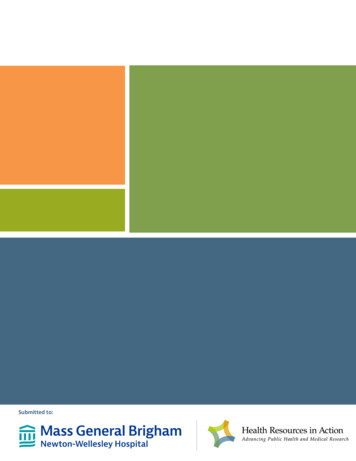
Transcription
August 16, 2021May 4, al2021CommunityHealthNeedsAssessment2021 Community Health Needs AssessmentDraftReportDraftReportl lSubmitted to:
Table of ContentsEXECUTIVE SUMMARY . iBACKGROUND . 7Overview of Newton-Wellesley Hospital . 7Summary of Previous 2018 Community Health Needs Assessment. 7Summary of Previous Community Health Implementation Plan FY18-20 . 7Purpose and Scope of 2021 CHNA . 7PROCESS AND METHODS . 8Approach and Community Engagement Process. 8Quantitative Data. 9Qualitative Data . 9Limitations . 10FINDINGS . 12Community Social and Economic Context . 12Community Resources and Assets . 35Community Health Issues . 37KEY THEMES AND CONCLUSIONS . 86PRIORITY HEALTH NEEDS OF THE COMMUNITY . 89APPENDIX A: Review of Initiatives . 90APPENDIX B: List of Community Benefits Committee Members . 118APPENDIX C: Newton-Wellesley Collaborative for Healthy Families and Communities (CHF&C) Councils. 119
EXECUTIVE SUMMARYBackground and MethodsNewton-Wellesley Hospital (NWH) is a 273-bed comprehensive medical center affiliated with MassGeneral Brigham, a network founded by Massachusetts General Hospital and Brigham and Women’sHospital. NWH’s mission is to treat and care for all its patients and their families as they would a belovedfamily member. In March 2021, NWH engaged Health Resources in Action (HRiA), a non-profit publichealth organization in Boston, to conduct its triennial community health needs assessment (CHNA). Ofnote, NWH received permission to provide an update to their 2018 CHNA for the 2021 cycle. NWH willpursue a full CHNA in 2022 to align with other facilities in the Mass General Brigham system.The CHNA used a participatory, collaborative approach and examined health in its broadest context. Aspart of this assessment, NWH sought input from its Community Advisory Board, known as theCommunity Benefits Committee, to inform the methodology, including recommendation of secondarydata sources. The assessment process included synthesizing existing data on social, economic, andhealth indicators from various sources, as well as, incorporating feedback from Community BenefitsCommittee members regarding health and social challenges in their area and recommendations for howto address these concerns.FindingsThe following provides a brief overview of key findings that emerged from this assessment.Community Social and Economic ContextThe following section provides an overview of the population within the NWH service area.Demographic characteristics: Age: Similar to the 2018 CHNA, according to the American Community Survey of the U.S. CensusBureau, with the exception of Waltham (13.7%), all of the towns in the NWH service area had ahigher percentage of children under 18 years of age compared to Massachusetts (20.0%). Focusgroup participants and interviewees described the population served by NWH as a mix, withaging adults, young families, and middle-aged persons.Racial and Ethnic Diversity: The diversity of the area was a characteristic previously named inalmost every interview and focus group for the 2018 CHNA. Since then, the racial/ethniccomposition of NWH’s service area has remained consistent. According to the most recentcensus data, Waltham had the highest percent of Black (6.7%) and Hispanic/Latino (13.6%)residents in the NWH service area, relatively similar to the proportion of Black (6.9%) andslightly higher than Hispanic/Latino (11.8%) residents for Massachusetts overall. Since the 2018CHNA, except for Needham and Newton, all towns experienced an increase in their immigrantpopulation. According to the most recent census data, all the towns had a higher percent ofresidents born outside of the US than the state (16.8%), except for Wellesley (16.9%) which wassimilar.i
Education: The high quality of the area’s school system was mentioned in most focus groups andinterviews and was described as one of the primary reasons for living in the assessmentcommunities. Similar to the 2018 CHNA, quantitative data indicate the six cities/towns in theNWH service area reported high levels of advanced collegiate education.Employment: Since the 2018 CHNA, trends suggest a decreases in the percent of residentsunemployed in all towns across the NWH service area but decreases ranged from 5.3% to 3.0%in Waltham to 4.4% to 4.0% in Weston. Of note, unemployment data following the COVID-19pandemic was not collected for this assessment.Income and poverty: Focus group participants and interviewees previously reported that the economicstatus of residents in the NWH service area varies by community in the 2018 CHNA. Residents living inNewton, Needham, and Wellesley were described as largely affluent, while Natick was described asmore middle class to upper middle class and Waltham was considered a more blue-collar community,with many lower income residents and a large proportion of public school students who areeconomically disadvantaged. According to the most recent census data, Weston (6.7%) and Waltham(5.3%) had the highest percent of families living below the poverty level, though this prevalence wasbelow that for the state (7.0%). According to the Massachusetts Department of Elementary andSecondary Education, within the service area cities and towns, Waltham had the highest proportion ofstudents who are economically disadvantaged (40.7%), meaning a student participates in certain publicassistance programs, a prevalence that exceeded Massachusetts overall (36.6%).Housing: The 2018 CHNA reported that the high cost of housing and changing housing dynamics aschallenges in the NWH service area. Residents previously spoke about rising rent, lack of affordablehousing and long wait lists. Participants described overcrowding and homelessness as two consequencesof high housing costs and limited options. According to the most recent census data, housing costburden was highest for renter-occupied units in Newton (46.7%) and owner-occupied units in Weston(35.8%).Transportation: Perceptions about transportation in the service area varied in the 2018 CHNA.Transportation to Boston was previously mostly reported to be easy and many residents from the NWHservice area traveled into the city. More locally, however, transportation options were reported to beless available, making travel from town to town difficult for those without personal vehicles. Reflectingpatterns across Massachusetts, the majority of workers in each assessment community drove to workaccording to the most recent census data, a trend that was similar to the 2018 CHNA.Food access and food insecurity: Feeding America projects an increase in food insecurity from 2019 to2020-2021 as a result of the COVID-19 pandemic. While Middlesex and Norfolk counties had lower ratesof food insecurity, both counties had higher average costs per meals 1 compared to the state overall.Higher food costs can contribute to an overall higher cost of living for individuals and families.Crime and safety: Focus group participants and interviewees previously perceived their communitieswere largely safe from crime in the 2018 CHNA. However, participants had expressed concerns aboutpersonal safety in some communities. Several participants had voiced concerns about the safety ofimmigrants and the fear of police in some communities. Similar to the previous CHNA, in 2019,Average cost per meal is “the average weekly dollar amount food-secure individuals report spending onfood divided by 21 (assuming three meals a day, seven days a week).” Feeding America, Map the Meal Gap, 20191ii
according to the Federal Bureau of Investigations, the violent and property crime rates were highest inWaltham (162.6 violent crimes and 816.1 property crimes per 100,000 population) and Natick (101.8violent crimes and 1,053.4 property crimes per 100,000 population). Property crimes rates decreasedacross the NWH region from 2017 to 2019, which was similar to the decrease seen in Massachusetts(1,561.1 to 1179.8) during the same time period.Community Resources and AssetsFocus group and interview participants previously identified several strengths of their community in the2018 CHNA. Community stakeholders and NWH Community Benefits department members elaboratedon how these strengths have been impacted by community programming and engagement since theprevious CHNA.Community amenities: Participants previously spoke about the quality of green spaces and recreationalopportunities available to them, as well as access to libraries, faith organizations, higher education,shopping, and the availability of cultural events in the. Additionally, participants appreciated the varietyand extensiveness of services in their communities, including healthcare, public health, andprogramming for children and youth. NWH Community Benefits members collaborate with these diversesectors to create programs and address community needs.Collaboration: Collaboration across different organizations was also reported as an asset in the NWHservice area. Participants shared examples of partnerships in the community including those betweenlocal police and schools and youth services organizations, work between public health departments andthose working in senior services. These partnerships were essential during the COVID-19 responseaccording to Community Benefits members.Generosity: Generosity of residents was described as another important community asset. Participantsdescribed how residents are active in their communities and generous with their time and financialresources. Residents look out for one another and desire to give back. Community Benefits membersexpressed how mutual aid networks funded through community support supported residents throughCOVID-19 pandemic.Strong local infrastructure: Several participants shared that the area has a strong business base andeffective local government, which they believed were substantial assets. Participants praised localpolice, fire departments, and school leadership.Community Health IssuesThe assessment identified several key health issues and concerns affecting NWH’s service area, namely:Leading Causes of Mortality: Similar to the 2015 and 2018 CHNAs, the leading causes of death in theNWH service area are heart disease and cancer, according to the Massachusetts Department of PublicHealth.Chronic Diseases and Related Risk Factors: Chronic diseases and related factors play a role in thecommunity’s mortality rate as well as their engagement with the health care system. According to theMassachusetts Department of Public Health, most cities and towns in the NWH service area had lowerrates of mortality due to heart disease as compared to the state (142.0 per 100,000 population), exceptfor Natick (144.8 per 100,000 population) and Waltham (144.3 per 100,000 population). The asthmaemergency department visit rate for Waltham residents (34.9 visits per 100,000 population) was almostiii
twice the rate for Needham residents (18.1 visits per 100,000 population), according to theMassachusetts Department of Public Health.Mental Health: Among community health issues raised during the 2018 assessment process, mentalhealth was the issue mentioned most frequently, particularly affecting elderly, immigrant, and lowincome residents. Relative to the other cities/towns in the NWH service area, a larger percent ofWaltham students reported depression, suicidal ideation, and suicide attempts, as noted in the previousCHNA. Middlesex and Norfolk County had a less favorable ratio of population per one mental healthprovider compared to the state.Substance Use: Substance use was also reported to be a substantial challenge for the community in the2018 CHNA. Opioids were the substance of greatest concern to participants. Substance use amongseniors was also reported to be an issue in the community, as well as use among youth. Substance usepatterns among youth varied across assessment communities: alcohol use was more prevalent inWeston, electronic cigarette use was highest in Waltham and in the Metro West region, and marijuanause declined in high school youth from Natick, Waltham, and Weston but increased in Newton students.Reproductive and Maternal Health: Quantitative data from the Massachusetts Department of PublicHealth demonstrates that similar to patterns across Massachusetts, from 2013 to 2015, the percent ofmothers with inadequate prenatal care increased slightly in Needham (11.1% to 13.0%), Wellesley(12.8% to 16.2%), and Weston (12.8% to 19.2%). Surveillance data for reproductive and maternal healthhas not been updated at a state or town level since the 2018 CHNA.COVID-19: The novel SARS-COV-2 pandemic, known as COVID-19, led to mild to severe illness,hospitalizations and death, in communities across the US and Massachusetts. While town level data waslimited, Waltham had the highest number of total COVID-19 cases across the region. Massachusettsresidents of color were experienced higher death rates due to COVID-19, which were consistent withnational trends. COVID-19 vaccinations were ongoing at the time of the assessment, but Black, Hispanic,and American Indian/Alaskan Native residents of Massachusetts reported lower vaccinations comparedto their White and Asian counterparts. In addition to physical health concerns, the pandemic affectedsocial and economic wellbeing across Massachusetts leading to increased job losses, economicinstability, social isolation, and other concerns.Communicable Disease: According to data from the Massachusetts Department of Public Health, thechlamydia case rate per 100,000 population for all cities and towns in the NWH service area are belowthe rate for Massachusetts. However, following patterns across the state, the chlamydia case rateincreased for all assessment communities from 2013 to 2018, with the greatest percent increase inWellesley (40.5%), Needham (35.2%), Waltham (34.6%), and Natick (24.2%).Access to CareAccess to affordable quality health care in important to physical, social, and mental health.Cost and Insurance: The cost of care, including insurance, co-pays, and medication, was mentioned byparticipants as a barrier to access, especially for lower income residents, including seniors. Obtaininginsurance was reported by participants to still be a challenge for residents, particularly those in theimmigrant communities. According to the most recent census data, a higher proportion of Blackresidents in Needham (12.8%), Waltham (7.6%), and Wellesley (6.5%) lacked health insurance relative tothe state (5.5%) and Middlesex (6.1%) and Norfolk Counties (4.4%).iv
Navigating the Healthcare System: Navigating complex healthcare systems was reported to be difficult,especially for residents with chronic illnesses or multiple providers. Continuity of care afterhospitalization can be a challenge for cancer patients, frail seniors, and those with chronic illnesses.Participants reported a need for a strong network of community-based services as well asadvocates/navigators to help patients navigate the healthcare system.Behavioral Health: Focus group and interview participants previously reported that mental health andsubstance use services are insufficient to meet demand. Some mentioned that many mental healthproviders don’t accept insurance or MassHealth, so people with mental health concerns, especiallythose who are lower income residents are undiagnosed or untreated. Additionally, stigma aroundmental health and substance use was shared as a substantial barrier to accessing care.Cultural Competency: The lack of cultural competency of providers, as well as limited access tolanguages other than English were identified as barriers for some community participants to accesshealthcare. Miscommunication between providers and residents about health conditions andtreatments was discussed, and according to one interviewee, led to improper use of medication. Thelack of providers’ knowledge and awareness of the unique needs of the LGBTQ population was alsomentioned by participants as a barrier.Transportation: According to participants, lack of cost-effective and convenient transportation optionscreates challenges to accessing health and other services in the NWH area, especially for lower incomeresidents. While some options exist, long wait times, spotty service, and cost were previously noted tomake it difficult for lower income residents and seniors to access medical care.Key Themes and ConclusionsThe 2021 NWH CHNA Report provides updated secondary data that was utilized in the 2018 CHNA byexamining social, economic, and health patterns and community concerns, and considers persistent andemerging health concerns since the 2018 CHNA. Several key themes emerged from this review:Community Strengths: Community stakeholders and NWH Community Benefits department memberselaborated on how community strengths have been impacted by community programming andengagement since the 2018 CHNA. NWH Community Benefits members described how the community’scollaboration, generosity, resources, and strong local infrastructure helped organizations come togetherduring the initial COVID-19 response and its ongoing aftermath. Several members emphasized howthese values have supported their community during a stressful and difficult time.Identified Areas of NeedHousing - The 2018 CHNA reported that the high cost of housing and changing housing dynamicsas challenges in the NWH service area. Since the 2018 housing costs have continued to rise forboth renter-occupied and owner-occupied units according to data from the U.S. Census.Transportation - Previously, residents reported that local transportation options were limited,and high transportation costs were challenging, especially for those without private vehicles.Food access and food insecurity - Feeding America projects an increase in food insecurity from2019 to 2020-2021 as a result of the COVID-19 pandemic. While Middlesex and Norfolk countiesv
had lower rates of food insecurity, both counties had higher average costs per meals 2 comparedto the state overall. Higher food costs can contribute to an overall higher cost of living forindividuals and families.Mental Health - Among community health issues raised during the 2018 assessment process,mental health was the issue mentioned most frequently, particularly affecting elderly,immigrant, and low-income residents. Relative to the other cities/towns in the NWH servicearea, a larger percent of Waltham students reported depression, suicidal ideation, and suicideattempts, as noted in the previous CHNA. COVID-19 was also noted by community benefitsmembers to have an impact on mental health during the pandemic.Substance Use - Substance use was also reported to be a substantial challenge for thecommunity in the previous CHNA, particularly related to opioids as well as specific concerns forseniors and youth.Access to Care - During the previous assessment, residents reported challenges in meeting thesocial, economic, and health care needs of all residents in the NWH service area, especiallyimmigrants, low-income residents, and seniors. A few participants previously reported thatobtaining health insurance was still a challenge for some residents, particularly those inimmigrant communities.Average cost per meal is “the average weekly dollar amount food-secure individuals report spending onfood divided by 21 (assuming three meals a day, seven days a week).” Feeding America, Map the Meal Gap, 20192vi
BACKGROUNDOverview of Newton-Wellesley HospitalNewton-Wellesley Hospital is a full system member of Mass General Brigham, a nonprofit organizationthat includes academic medical centers Massachusetts General Hospital and Brigham and Women'sHospital. Serving its community for more than 130 years, NWH provides a wide range of services to itssurrounding communities, including medical, surgical, obstetric and gynecological, cardiovascular,emergency, orthopedic, neonatal, pediatric, hematology/oncology and psychiatric care—with a medicalstaff of more than 1,000 physicians practicing a full range of specialties. NWH is a major teachinghospital for Tufts University School of Medicine and has established post-graduate training programs forresidents of Massachusetts General Hospital and Brigham and Women’s Hospital, teaching hospitals ofHarvard Medical School.Summary of Previous 2018 Community Health Needs AssessmentIn 2018, Newton-Wellesley Hospital completed a community health needs assessment (CHNA) of itsprimary service area (Natick, Needham, Newton, Waltham, Wellesley, and Weston) using aparticipatory, collaborative approach that examined health in its broadest context. The purpose of thisCHNA was to provide an empirical foundation for future health planning of communities served byNWH. The 2018 CHNA also fulfilled the community health needs assessment mandate for non-profitinstitutions as put forth by the MA Attorney General and the IRS. The assessments process includedsynthesizing existing data on social, economic, and health indicators, as well as conducting six focusgroups and eight interviews with a range of diverse individuals to identify the perceived health needs ofthe community, challenges to addressing these needs, current strengths and assets, and opportunitiesfor action. The 2018 assessment identified the following areas of needs: housing, transportation, mentalhealth, substance use, access to care, and cancer. Previously collected information on these healthissues, as well as community assets and resources, can be found in the 2018 assessment report availableNWH’s website: https://www.nwh.org/media/file/chna.pdf.Summary of Previous Community Health Implementation Plan FY18-20Following its 2018 CHNA process, NWH developed a plan to address the following priority areas: mentalhealth, substance use, access to care, social determinants of health, chronic disease management andprevention, and other identified community health needs. The 2019 plan is available on NWH’s website:https://www.nwh.org/media/file/CHIP.pdf. Since the 2018 CHNA, NWH has provided a variety ofservices and programming to address the identified key needs and issues (see Appendix A).NWH included six priority areas in its 2018 implementation plan to address the needs of its service areaand the table in Appendix A reviews the impact of that work. It is organized by priority area and includesa description of activities, services, and programs. The impact of these activities in FY’ 2018, 2019, and2020 is demonstrated by numbers of individuals served, services provided, and goals achieved.Purpose and Scope of 2021 CHNAIn the spring of 2021, NWH decided to align their CHNA and planning cycle with that of their parenthealth system, Mass General Brigham. To accomplish that, NWH decided to complete a brief update totheir 2018 CHNA and develop an accompanying one-year plan. The new three-year cycle will start in7
2022 with the development of a full, detailed CHNA and three-year Community Health ImprovementPlan (CHIP).PROCESS AND METHODSThe following section describes how data for 2021 CHNA were collected and analyzed. This section alsoprovides an overview of the health framework that guided this assessment process. This CHNAconceptualizes health in the broadest sense and recognizes that factors at multiple levels shape thecommunity’s health. These include, for example, lifestyle behaviors (e.g., physical activity and smoking),clinical care (e.g., access to medical services), social and economic factors (e.g., employmentopportunities), and the physical environment (e.g., access to healthy food).Definition of the Community ServedThe 2021 NWH CHNA focused on the six cities and towns that comprise the Hospital’s primary servicearea. These communities are Natick, Needham, Newton, Waltham, Wellesley, and Weston. While theCHNA process aimed to examine health concerns across the entire service area, there was a particularfocus on identifying the needs of the most underserved population groups of the area, as well as furtherexploration of the key priorities identified by the previous CHNA.Approach and Community Engagement ProcessSocial Determinants of Health FrameworkFigure 1, below, provides a visual depiction of the multiple factors that shape health. Individual lifestylefactors, located closest to health outcomes, are influenced by upstream social and economic factorssuch as housing, educational opportunities, and occupational factors. The beginning of the CHNAdescribes many of these social and economic factors, and reviews key health outcomes among residentsof the Newton-Wellesley Hospital service area.Figure 1. Social Determinants of Health Framework8
DATA SOURCE: World Health Organization, Commission on the Social Determinants of Health, Towards aConceptual Framework for Analysis and Action on the Social Determinants of Health, 2005.Community Benefits Committee EngagementMembers of the NWH Community Benefits Committee provided strategic oversight of the CHNAprocess. This committee is comprised of 24 community stakeholders from the hospital service area andNewton-Wellesley Hospital staff and administrators involved in strategic planning and communitybenefits efforts. A list of members can be found in Appendix B. The Community Benefits Committeeguided several parts of the assessment including the design of CHNA methodology, recommendation ofsecondary data sources, and highlighting community voices during the data assessment process.Following the 2018 CHIP, the Newton-Wellesley Collaborative for Health Families and Communities(CHF&C), under the Community Benefits Committee guidance, formed eight councils around the focusareas identified by the 2018 CHNA. Each council has approximately 20 members and include NWHhealth care providers, community partners, and volunteer community members. The eight councils are: Cardiovascular Council Domestic and Sexual Violence Council Elder Care Council Maternity Service Council Palliative Care Council The Resilience Council Substance Use Council Workforce Development CouncilEach council meets quarterly to address community needs and implement community health priorities,informed by previous 2018 CHIP strategies and 2018 CHNA data. See Appendix C for further informationon the councils.Quantitative DataSecondary data provide information about social and economic indicators, as well as health behaviorsand health outcomes along the cancer continuum, specifically prevention and screening. When possible,this CHNA compared indicators from the 2018 CHNA to most recent data for the NWH service area. Datasources included: the U.S. Census Bureau, American Community Surveys, County Health Rankings, theMassachusetts Behavioral Risk Factor Surveillance System (BRFSS), the Massachusetts Department ofPublic Health, MetroWest Health Foundation, the Massachusetts Department of Elementary andSecondary Education, and the Federal Bureau of Investigation. Some data resources from theMassachusetts Department of Public Health have not been updated from the previous CHNA due tolimitations on data requests in light of COVID-19’s burden on health departments.Qualitative DataAs noted earlier, the 2021 NWH CHNA process is a limited process to set up the hospital for broader,more engaged process in 2022. For this CHNA process, all qualitative data collection and residentcommunity engagement was done through the Community Benefits Committee and the CHF&C councilsand focused on the implementation of community benefit activities and response to the COVID-19pandemic.9
LimitationsAs with all research efforts, there are limitations related to the assessment methods that should beacknowledged. First, for quantitative data sources, in several instances data for a given indicator couldnot
Newton-Wellesley Hospital (NWH) is a 273-bed comprehensive medical center affiliated with Mass General Brigham, a network founded by Massachusetts General Hospital and Brigham and Women's Hospital. NWH's mission is to treat and care for all its patients and their families as they would a beloved family member.

